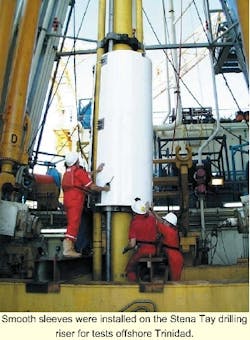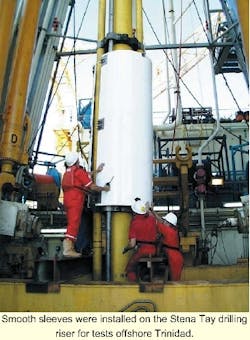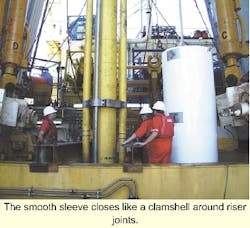FLOATING PRODUCTION: Smooth-sleeve drilling/production risers eliminate VIV, drag effects
While the basic understanding of vortex induced vibration (VIV) has been around since the beginning of the last century, a recent discovery by researchers at Shell Inter national E&P may change the way that technologists treat this phenomenon. VIV occurs when currents move across cylinders at a rate high enough to make them vibrate. This vibration can cause fatigue prob lems in tubulars and interfere with instal lation and drilling operations.
Shell has re searched how this phenomenon takes place in different size tubulars. Don Allen, Research Engineer with Shell International E&P, claims the company holds about 90% of the relevant VIV data on drilling and production risers. He himself has conducted more that 50 experimental programs on the effects of currents moving across a cylinder. The variables in such experiments include the velocity of the currents and the diameter and length of the cylinder.
Allen performs these tests at the (US) Naval Surface Warfare Center in Carderock, Maryland. At the center's David Taylor Model Basin, a variety of cylinders are examined as they are moving through the water on a rotating arm at speeds high enough to generate critical and super-critical Reynolds numbers (velocity times diameter over kinematic viscosity) in the range of 100,000 to 400,000.
Cylinder test design
To reach such numbers on cylinders of greater diameter, Allen said it was necessary to have the cylinders custom-made from fiberglass composite materials. In previous tests, simple PVC pipe was used. To be flexible enough for the tests, yet rigid enough not to fail, the larger diameter pipes composites became the material of choice.
However, this left a very rough surface that Allen feared would interfere with the quality of the test. It was then decided to have the surfaces of these tubulars ground down smooth, so that they were similar to the surfaces of other pipes tested. It was this polishing process that led to Allen's discovery.
The new pipes were installed on the rotating arm and the experiment conducted. Allen became concerned when the rotating arm reached the velocity calculated to produce the critical Reynolds numbers. At this point, the pipe should have been vibrating violently, but there was no movement at all.
Allen said that if he had not had such a long history of performing VIV experiments, he might not have realized that a breakthrough had been made. His first reaction, he said, was "What did I do wrong?" It was later that night that he hit upon the difference in the experiment.
As part of the experiment protocol, Allen kept a record of the roughness of each piece of pipe tested over the years. The formula (roughness height divided by pipe diameter) gives a measurement of how rough the surface is. Allen had a sample of the composite pipe examined and determined it was slightly less rough than the PVC he had been using all along. It was a combination of the smoother surface and larger diameter that made the critical difference.
Further tests were conducted on pipes with various degrees of surface roughness to validate Allen's findings. Not only did the smooth surface of the pipe eliminate VIV at critical Reynolds numbers, but it also reduced drag substantially.
Testing discovery
Drilling risers are often subjected to VIV and drag problems during periods of high loop currents (A Gulf of Mexico phenomenon, which exists elsewhere). This can interfere with operations and cause drilling to shut down. Allen said the problem has been addressed in the past with strakes, fairings, and other devices installed on the outer surface of the risers and designed to interrupt the cycle that leads to vibration.
The deepwater drilling riser has a variety of non-cylindrical features. Many joints are encased in syntactic foam buoyancy modules. The bare joints have choke and kill lines exposed, and the bolts on flanges and the straps that hold the buoyancy to the riser all work against the smooth sleeve concept.
To overcome this, Shell has designed the smooth sleeve, a near perfect cylinder that encases the riser joints. Each smooth sleeve is about 10-ft long and has a diameter to fit the riser. The sleeves are made of fiberglass with a gel coat. A number of these sleeves can be installed on one riser joint. Allen said Shell has developed a formula for placement of these on risers. Once the riser is installed and placed in tension, these sleeves protect it from VIV and reduce drag by 30-60%.
The system was first tested in the field on the Stena Tay drilling unit, working offshore Trinidad. Forty of these sleeves were built, however test data showed that only 30 were needed. "We were analyzing data, as we were making decisions," he said. The current profile dictates how many sleeves are needed and where they are to be placed.
Allen said the rig encountered a 2-knot current, the rate calculated to produce VIV, and none was encountered. In addition, there was virtually no riser deflection. Allen said, in such a current, a deflection of .5 to 1 degree is common.
While this was a successful field test, there are still problems to overcome. Allen said that the time to install the sleeves is a concern during running or pulling the riser, although they are not used on the entire riser.
Also, the sleeves are delicate and will not function if they become damaged. These questions will drive future research, but Allen said there are broader issues to be excited about. For example, he wants to know the effect of scratches on the smooth sleeves, and the difference between vertical and horizontal scratches.
Tension leg platforms
Beyond the protection of drilling risers is the question of installing tension leg platforms (TLP). Typically, this exercise involves the making up and handing over of very long tendon strings to the platform. Once the tendons are hung off the platform, they are moved slowly into position over the riser bases on the seabed.
Each step in this process from the making up of tendons to the passing off and the maneuvering of the platform is weather dependent. Increases in currents can slow or halt the process, costing time and money. Even in very calm waters, the motion of the TLP, as it is moved into place, can act on the tendons to produce VIV.
Allen said his experiments have clearly shown that because the tendons have a smooth coating already applied, the weather window for all these activities is much broader than previously thought. This means the tendons can be made up and passed over to the platform, even when significant loop currents are present. More importantly, the platform can be brought into position much faster without fear of damaging the tendons.
While these are the primary offshore applications of this new finding, Allen said Shell is looking at a way to apply this to production risers as well and to other cylinders that may start out smooth, but become rough due to marine growth accumulation.


